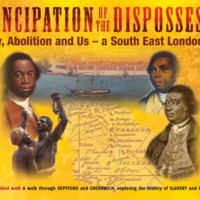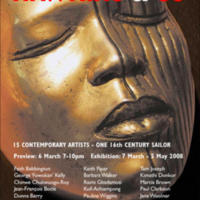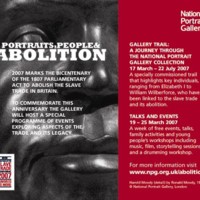
Emancipation of the Dispossessed: Slavery, Abolition and Us - a South East London angle
Emancipation of the Dispossessed was a local community project exploring the local history of Deptford and the surrounding areas and the connections with the transatlantic slave trade. Community groups and students from Lewisham College worked with theatre educators to research and develop 'Blood Sugar', a promenade performance through the Queen's House, Greenwich. The play, written and directed by John Turner, tells the story of slavery and abolition from a local angle, and the script was built around first-hand and eyewitness accounts, campaign pamphlets and reports to parliament. The project also produced learning resources aimed at Key Stage 3 History and Citizenship.
A guided walk explored Deptford’s links to the history of the transatlantic slave trade, uncovering stories of some of the local people who played an important role in the beginnings of the slave trade or the campaign for its abolition. London was an important slave trading port before Bristol and Liverpool dominated the trade. The trade and British colonies were protected by the Royal Navy, whose ships were built and prepared for voyages at the Royal Dockyards at Deptford.

Hawkins & Co
Curated by artist Kimathi Donkor, and first exhibited at London’s Elspeth Kyle Gallery, Hawkins & Co referred to the Elizabethan mariner Sir John Hawkins, whose 16th century voyages to Africa and the Caribbean pioneered the British slave trade. In 2008, an expanded version of the project, featuring over 70 artworks from 15 contemporary artists, was exhibited at Liverpool’s Contemporary Urban Centre. The display included artworks by Keith Piper, Barbara Walker and Raimi Gbadamosi, and a new commission from Jean-François Boclé. Each piece on show explored a different aspect of the culture and history of the transatlantic African-Caribbean diaspora affected by Hawkins’ legacy.
In 2017, a key work from the project - 'UK Diaspora' - was added to the permanent collections of the International Slavery Museum.

Portraits, People and Abolition
The National Portrait Gallery created a new gallery trail to mark the bicentenary, written by Dr Caroline Bressey. The trail highlighted portraits of key individuals, ranging from Elizabeth I to William Wilberforce, linked to the slave trade and its abolition. Portraits included those who invested in the trade, or who owned slaves and supported slavery, as well as images of enslaved people themselves and of people who were prominent in the movement to abolish the trade. The trail ended with a series of contemporary portraits of individuals involved in preventing slavery today. A week of talks, music, film and family activities included a discussion of the painting 'The Anti-Slavery Convention, 1840' by Benjamin Robert Haydon.